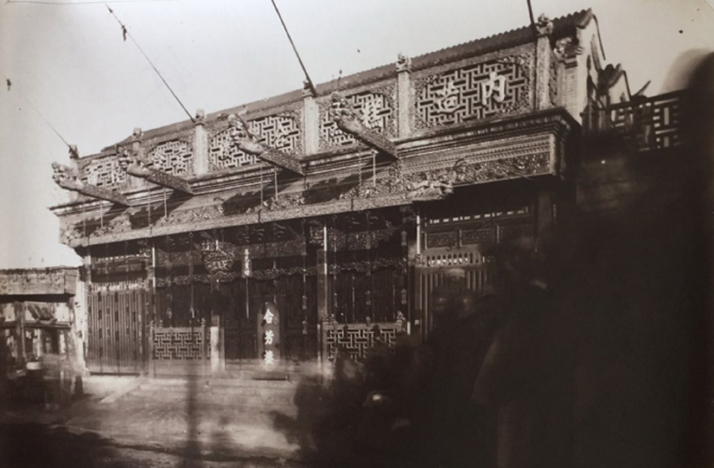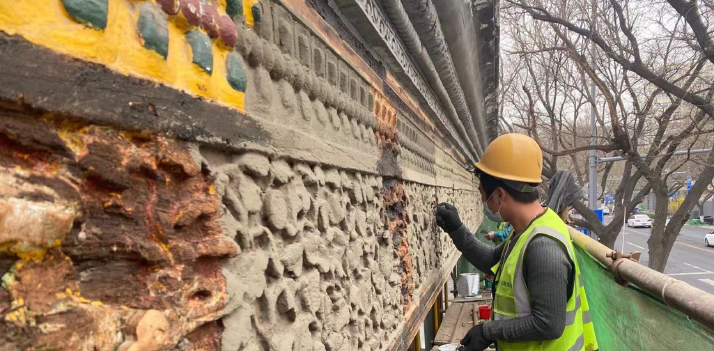| Lifestyle |
| The renovation of Dongsi Street in Beijing is a blueprint for historical block upgrades | |
|
|
 No.108 Dongsi South Street in Dongcheng District in Beijing in 1901 (COURTESY PHOTO)
No.108 Dongsi South Street in Beijing consists of three clothing stores. However, they were once connected and belonged to an old brand. When renovations on Dongsi Street, located in Dongcheng District started in July 2020, experts from the China Academy of Urban Planning and Design removed its marble facade and uncovered a traditional building, the eaves and oil decorations and paintings of which have remained intact. "It is an exciting discovery as those old components are well preserved," Zhang Hanyu, head of the project, told Beijing Review. After browsing historical files such as old photos, they found their answer—it was the site of one of the earliest bakeries in Beijing hundreds of years ago, namely Hefanglou. The dessert store, established in the Yuan Dynasty (1279-1368) and fading into history in the late Qing Dynasty (1644-1911), was widely famed for its diverse and appetizing flavors. The team then came up with a plan to protect and renovate the building. Using traditional techniques and materials, they reinforced its pillars and strengthened the beams, as well as fixed or replaced the eaves and stone carvings. Including No.108, a total of 16 ancient buildings were revamped. Their significance not only lies in the preservation of traditional style, but also in telling the historical tales of Dongsi Street, he said. Dongsi Street, made up of southern and northern parts, rolls out for nearly 2.8 km. Since the Yuan Dynasty, it has been a commercial district. Today, nearly 70 percent of architecture lined up along the street is still used for commercial purposes. "Dramatic changes have taken place on this street due to buzzing business activities in the past centuries. Some with detrimental effects on the living conditions and overall style of the street," Zhang added. At the same time, the program of modifying the living environment in Beijing's hutongs, the city's traditional alleyways that was initiated four years ago, has made remarkable progress. Their transformation culminated in the upgrading of the areas where those alleys finally converge. Wrapping up in early 2021, the Dongsi Street project is a leading example of one such renovation.  The building of No.189 of Dongsi Street was divided by three stores seen here right before the renovation project launched in July 2020 (COURTESY PHOTO)
Stories in history Today, walking down Dongsi area, people may feel like passing through the rushes from an old movie of decades ago. Historical flavors aside, this block has successfully realized the combination of traditional life in a commercial and cultural setting. Zhang's team had extensive talks with local residents and conducted a deep research into he district government's official archives to identify the antique buildings. Photos played an important role in the process, especially those taken between the early 1950s and late 1960s. Zhao Xing, a senior engineer at the Beijing Municipal Institute of City Planning and Design, participated in the project and explained that those photos provided the most complete records of the original Dongsi Street look. "We compared all historical archive related and redecorated buildings that did not blend in with the street's original style," Zhao said. Nevertheless, after thoroughly inspecting Dongsi Street, Ma Bingjian, an expert on Chinese ancient architecture, reminded them that renovating the old blocks was not necessarily a matter of restoring all buildings to one particular historical period with a unified style. Consequently, the team started by taking down the ubiquitous billboards and removing all exterior decorations. "History had left the street with buildings featuring miscellaneous characteristics of the olden dynastical days, such as the traditional courtyard houses, smaller buildings that presented the style during 1911-49, and then the more modern ones," Zhang said, adding their principle was to present the true look of each. Moreover, keeping cultural heritage intact, the overall recycling rate of brick and tiles during the renovation process, reached 43 percent. At the same time, another team of experts established archives for the historical buildings, delving into their rich stories. Besides elevating the street's cultural resources, the archives contribute to the future protection of cultural relics. People-centered Over 400 households live along Dongsi Street, mainly running their own businesses in the area. To persuade them to accept the upcoming changes, the team had to spend much time and energy on communicating with local residents to protect what's old and ensure what's public. Regulations, too, became necessary, with each shop, for instance, only allowed one billboard—not blocking the building's decorations. Adhering to a people-centered philosophy, the team also tried to meet the individual needs of locals. No.139 is a lamp shop operated by an 80-year-old man. After removing all unauthorized elements from the building, Zhang found its height could reach up to 6 meters. He suggested the man give full play to this advantage and introduced several features of the new Chinese style—a style combining simple and practical designs together with traditional Chinese artistic patterns. Yet the man refused to make so many changes to the shop to which he had devoted his life. Therefore, the upgrading plan allowed him to concentrate on materials and decorative elements.  A worker carefully repairs the damaged decorative sections of the building in Dongcheng District (COURTESY PHOTO)
Today, the street takes on a new look of traditional legacy and metropolitan charm unique to Beijing. Zhang and his team have moved onto the next stage, namely those of how to help stores take advantage of their characteristics and adjust to new business models, and how to improve living quality in the courtyards. The upgrade of these historical blocks has many, some unforeseen, aspects, but solving people's daily problems is at the top of the agenda, Zhang said. Facilities for the disabled and seniors, convenient transportation and an improved power supply have all been taken into consideration. Renovating the street is far more than just restoring an architectural style, he said. Since wrapping up his work on the site, Zhang has ventured back to the area many times, evoking memories of his work on the site. His parents and friends also asked him to show them around as he is one of the people most knowledgeable about the street. "I will take my child here in the future and tell him the stories behind the buildings. But they will probably have to be renovated again by that time," he laughed. (Printed Edition Title: Past and Present) Copyedited by Elsbeth van Paridon Comments to liqing@bjreview.com |
|
||||||||||||||||||||||||||||
|